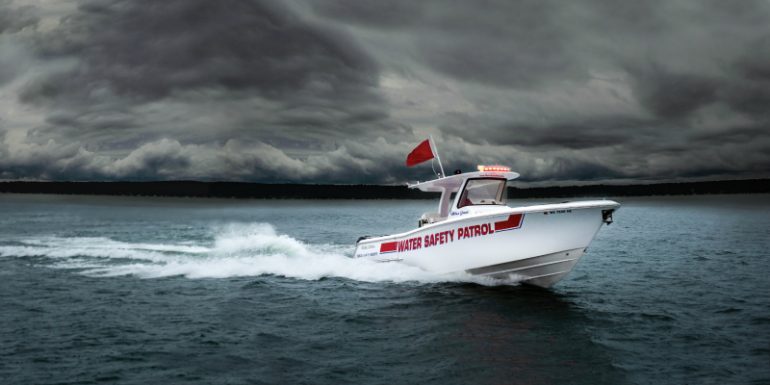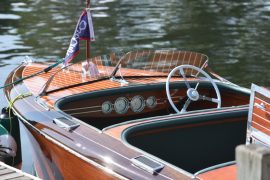The First 100 Years of the Water Safety Patrol: 1920-2020
By Anne Morrissy
The idea of documenting the history of the Geneva Lake Water Safety Patrol and the stories of its many dedicated employees is one that has been discussed for years. Patrollers, as they’re called, are a tight-knit group, many of whom consider themselves “lifers” in the organization. For many of those lifers, reminiscing about the summers of their youth inevitably returned time and time again to writing a book. It wasn’t until the approaching 100th anniversary of the organization, to be marked next year, however, that a committee of Patrollers was formed to turn this idea into reality. Book committee members Tara Schreiner, Maggie Cambria, Ted Pankau, Leigh Otzen, Kelly Otzen and Sean Slattery enlisted the help of writer Anne Morrissy to create the only comprehensive overview of the history of this one-of-a-kind institution. The book features interviews with more than 50 current and former Patrollers as well as hundreds of never-before-seen photographs.
At The Lake is pleased to present excerpts from the book which is scheduled to be released Oct. 12, 2019. It will be available through the Water Safety Patrol and from a variety of local retailers. As the release date approaches, purchasing details will be available at WaterSafetyPatrol.org.
CHAPTER 2: Waterproof Geneva Lake
The Founding of the Water Safety Patrol and its Early History: 1920-1940
By 1920, the Lake Geneva area had evolved into an established and trendy summer haven for wealthy families from nearby cities like Chicago, Milwaukee, Rockford and Madison, earning it the nickname “Newport of the West.” At the same time, the introduction of the automobile and the proliferation of paved roads ushered in a new kind of vacation — the “road trip” — and more and more day trippers and short-term vacationers came to the area to enjoy the lake’s natural amenities, with more hotels springing up to accommodate them. The most famous of these, the Frank Lloyd Wright-designed Geneva Hotel, had opened in downtown Lake Geneva in 1911. The public beaches in Lake Geneva, Williams Bay, Fontana and Buttons Bay were busier than ever before.
On the lake itself, the combination of more speedboats and more visitors using the lake made the environment ripe for tragedy. In 1920, recognizing the dangers of the lake, Chicago stockbroker and philanthropist Simeon B. Chapin devised a solution to combat these mounting water safety challenges. Chapin had lived with his family at his Lake Geneva summer home, Flowerside Farm, for more than 20 years. He also served on the board of trustees at George Williams College Camp in Williams Bay and was a strong supporter of the Lake Geneva YMCA. The drowning death of a young man visiting George Williams that summer surely weighed on his conscience as he set out to improve the level of water safety awareness around Geneva Lake. Gathering a group of like-minded lake residents, Chapin solicited private donations to form a new local organization to promote water safety awareness and rescue: the Water Safety Patrol was born.
The group started as an extension of the Lake Geneva chapter of the American Red Cross, which had been founded in 1916 to promote war preparedness prior to America’s entry into WWI. When the war ended, the chapter turned its attention to domestic projects, embracing water safety and education. Because of this, the Patrol’s original name was the Water Safety Committee of the Red Cross, though from the earliest days, it was more commonly referred to as the Water Safety Patrol. The new group’s first efforts focused on public education and awareness. They funded the printing of water safety posters to be displayed at various piers and camps around the lake and used the remaining funds to hire one full-time lifeguard for the beach in Lake Geneva, purchasing a rowboat to assist him in deep-water rescues.
But Chapin and the other early benefactors proved to be forward-thinking leaders, on the cutting edge of a movement that was quickly gaining steam in the Midwest. In 1924, a newspaper item from Oshkosh mentions a “water safety program” that drew participants from around the state to the Lake Geneva area for a three-week training course. The following year, the Annual Red Cross Institute met at Conference Point Camp in Williams Bay and this jump-started efforts to expand the Water Safety Patrol. Following that meeting, the Water Safety Patrol board hired the organization’s first director, Wendell Berger, and worked out a loan arrangement with Northwestern Naval and Military Academy to acquire use of the first Patrol boat. That year, the Patrol also expanded to 12 full-time lifeguards, as well as a growing stable of volunteer “lifeguard assistants,” all of whom were required to pass the newly established American Red Cross lifesaving test. At the end of the 1925 season, the board prepared a report on the Patrol’s activity: 724 students participated in swimming lessons, seven water safety demonstrations reached an audience of 1,450 people and Patrol lifeguards provided 2,000 hours of coverage at a total of 15 sites around the lake. “Many lives are reported as having been actually saved,” Bonnie Burton Denison, the report’s author, added. She goes on to add that the National Red Cross headquarters in St. Louis was so impressed by the work of the Water Safety Patrol that they released the report to newspapers and university publications throughout the Midwest in the hope that other lakes would establish similar organizations…
RUNNING THE REDS
Beginning in the 1950s, the Water Safety Patrol introduced the protocol of flying a red flag to warn of storms in the area. For the first few years the strategy was implemented, Mavis McGhye, dispatcher/secretary in Patrol headquarters, would telephone a list of homes, camps and businesses around the lake, each of which would then fly a large, red flag from the end of their piers to warn boaters and swimmers of the imminence of a storm. But in 1954, Board Member George F. Getz, Jr., suggested flying the red flags from the Patrol boat itself as the boat made a warning lap around the lake. Thus began a tradition that continues to this day.
The sight of a Patrol boat zipping by with red flag flying and red lights flashing has become a much-appreciated local service and has prevented countless hazardous situations by encouraging boaters and swimmers to clear the lake as quickly as possible. Among the Patrol, the activity is known as “Running the Reds.” Former Boat Crew member and current Board President Leigh Otzen described the sense of duty and adrenaline surrounding a storm: “Running the Reds was one of my favorite things we got to do on the Boat Crew,” he explained. “You would see the dark storm clouds on the horizon, and you knew. You were just waiting for Headquarters to make the call. In the meantime, the crew would get things ready, and put on their rain gear. Suddenly the wind would shift and pick up in velocity, and the temperature would drop 10 or 15 degrees. It was only a matter of time until you heard the dispatcher or Ted make the call: ‘Run the Reds!’”
CHAPTER 7:A Monumental Job
Spotlight on the Boat Crew
Since the Water Safety Patrol added its first boat to the fleet in 1925, the Boat Crew has been the backbone of the organization and arguably its most visible branch. First and foremost, the Boat Crew acts as a safety and prevention unit, stopping boats on the lake when necessary and educating drivers about a variety of dangerous activities: overloading of passengers, water-skiing without a spotter, driving in designated swim areas… the list is lengthy.
In addition to routine patrolling activity, the Boat Crew also serves as a mobile emergency response unit, trained in everything from emergency boat tow procedures to lifesaving skills. In any boating accident on Geneva Lake between Memorial Day and Labor Day, the Water Safety Patrol’s Boat Crew is often the first responder on the scene, frequently arriving within minutes of an accident or injury. Once they arrive on the scene, the Boat Crew uses their skills and knowledge to triage and treat the victims according to injury, and they often radio in a request for an ambulance to meet them at a designated pier, transporting victims to shore for further medical help.
Even more commonly, the Boat Crew responds to calls regarding distressed boats: overturned or turtled sailboats, speedboats whose engines have died. Veteran Boat Crew members pride themselves on their ability to maneuver a distressed boat under tow into even the tightest, hardest-to-reach boat slips on the lake. They also stop runaway boats, assist the Fire Boat in putting out boat fires and provide assistance at the beaches when drownings or medical emergencies happen.
As a result of this high level of activity, the Boat Crew depends heavily on their own fleet of Water Safety Patrol boats. These boats must be unusually durable and able to withstand a wide variety of conditions. Throughout its 100-year history, the Water Safety Patrol has cycled through dozens of boats in its fleet, each with its own set of strengths. The longest-serving of these boats is the current Boat #1, the Richard W. Scherff, which has been in active service since 1966. Today, in addition to Boat #1, the Water Safety Patrol maintains five more boats, according to director Ted Pankau, most of which were custom-built specifically for the needs of the organization…






Comments are closed.